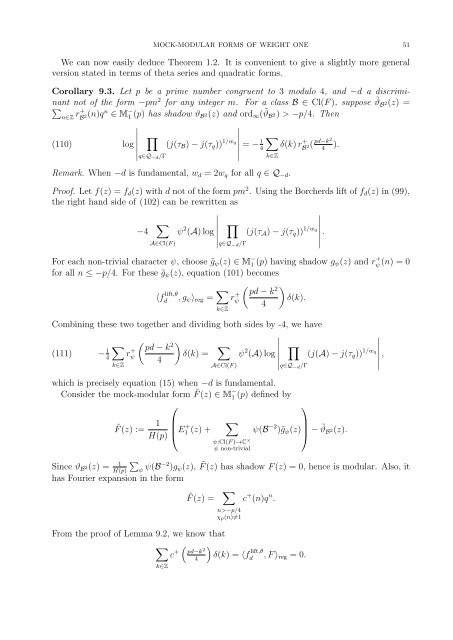Mock-modular forms of weight one - UCLA Department of Mathematics
Mock-modular forms of weight one - UCLA Department of Mathematics
Mock-modular forms of weight one - UCLA Department of Mathematics
You also want an ePaper? Increase the reach of your titles
YUMPU automatically turns print PDFs into web optimized ePapers that Google loves.
MOCK-MODULAR FORMS OF WEIGHT ONE 51<br />
We can now easily deduce Theorem 1.2. It is convenient to give a slightly more general<br />
version stated in terms <strong>of</strong> theta series and quadratic <strong>forms</strong>.<br />
Corollary 9.3. Let p be a prime number congruent to 3 modulo 4, and −d a discriminant<br />
not <strong>of</strong> the form −pm 2 for any integer m. For a class B ∈ Cl(F ), suppose ˜ϑ B 2(z) =<br />
∑<br />
n∈Z r+ B<br />
(n)q n ∈ M − 2 1 (p) has shadow ϑ B 2(z) and ord ∞ ( ˜ϑ B 2) > −p/4. Then<br />
∣<br />
(110) log<br />
∣<br />
∏<br />
q∈Q −d /Γ<br />
(j(τ B ) − j(τ q )) 1/wq ∣ ∣∣∣∣∣<br />
= − 1 4<br />
∑<br />
Remark. When −d is fundamental, w d = 2w q for all q ∈ Q −d .<br />
k∈Z<br />
δ(k) r + B 2 ( pd−k2<br />
4<br />
).<br />
Pro<strong>of</strong>. Let f(z) = f d (z) with d not <strong>of</strong> the form pm 2 . Using the Borcherds lift <strong>of</strong> f d (z) in (99),<br />
the right hand side <strong>of</strong> (102) can be rewritten as<br />
∣<br />
−4<br />
∑<br />
∏<br />
∣∣∣∣∣<br />
ψ 2 (A) log<br />
(j(τ A ) − j(τ q )) 1/wq .<br />
∣<br />
A∈Cl(F )<br />
q∈Q −d /Γ<br />
For each non-trivial character ψ, choose ˜g ψ (z) ∈ M − 1 (p) having shadow g ψ (z) and r + ψ (n) = 0<br />
for all n ≤ −p/4. For these ˜g ψ (z), equation (101) becomes<br />
〈f lift,θ<br />
d<br />
, g ψ 〉 reg = ∑ ( ) pd − k<br />
r + 2<br />
ψ<br />
δ(k).<br />
4<br />
k∈Z<br />
Combining these two together and dividing both sides by -4, we have<br />
∣<br />
∑<br />
( ) pd − k<br />
(111) − 1 r + 2<br />
4 ψ<br />
δ(k) =<br />
∑<br />
∣∣∣∣∣ ∏<br />
ψ 2 (A) log<br />
4<br />
(j(A) − j(τ q )) 1/wq ,<br />
∣<br />
k∈Z<br />
A∈Cl(F )<br />
which is precisely equation (15) when −d is fundamental.<br />
Consider the mock-<strong>modular</strong> form ˜F (z) ∈ M − 1 (p) defined by<br />
⎛<br />
˜F (z) := 1<br />
H(p)<br />
⎜<br />
⎝ E+ 1 (z) +<br />
∑<br />
ψ:Cl(F )→C ×<br />
ψ non-trivial<br />
q∈Q −d /Γ<br />
⎞<br />
ψ(B −2 )˜g ψ (z) ⎟<br />
⎠ − ˜ϑ B 2(z).<br />
∑<br />
Since ϑ B 2(z) = 1<br />
H(p) ψ ψ(B−2 )g ψ (z), ˜F (z) has shadow F (z) = 0, hence is <strong>modular</strong>. Also, it<br />
has Fourier expansion in the form<br />
˜F (z) =<br />
∑<br />
c + (n)q n .<br />
From the pro<strong>of</strong> <strong>of</strong> Lemma 9.2, we know that<br />
∑ (<br />
c +<br />
k∈Z<br />
pd−k 2<br />
4<br />
n>−p/4<br />
χ p(n)≠1<br />
)<br />
δ(k) = 〈f lift,θ<br />
d<br />
, F 〉 reg = 0.
















